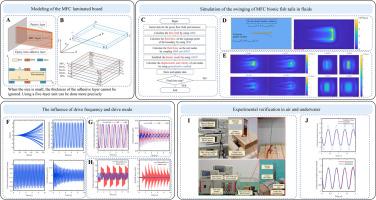基于ANCF的MFC驱动柔性仿生尾鳍水下振荡建模与分析
IF 6.6
1区 工程技术
Q1 ENGINEERING, CIVIL
引用次数: 0
摘要
随着仿生鱼研究的深入,一种以智能材料为驱动的新型仿生鱼设计逐渐出现。宏纤维复合材料(MFC)作为致动器具有优异的柔性和压电驱动性能。因此,基于MFC的柔性仿生鱼具有广阔的应用前景。然而,柔性尾鳍的多物理场耦合(固-流-电)和MFC作动器在大摆动游动过程中的机电耦合是需要解决的两个问题。本文研究了由MFC驱动的尾鳍-尾鳍(BCF)推进系统,将主驱动尾鳍简化为两侧有MFC贴片的基片,并采用绝对节点坐标公式(ANCF)建立了其动力学模型。引入考虑机电耦合效应的MFC本构模型来计算尾鳍模型的机电耦合。采用浸没边界-晶格玻尔兹曼方法计算了尾鳍模型的流固耦合。采用考虑环氧胶层的五层单元来解决变形耦合问题。采用广义α法求解系统动力学方程,实现了多物理场作用下尾鳍模型动态响应的数值模拟。实验验证理论与测量结果吻合良好,远端位移误差为3.98%。该方法可以准确表征电驱动下MFC仿生鱼在流场中的响应。本文的研究成果对柔性仿生鱼的设计具有一定的理论和应用价值。本文章由计算机程序翻译,如有差异,请以英文原文为准。

Modeling and analysis of underwater oscillation of a flexible biomimetic caudal fin driven by MFC based on ANCF
With the deepening bionic fish research, a novel biomimetic fish design driven by smart materials has gradually emerged. When used as actuators, macro fiber composites (MFC) exhibit excellent flexibility and piezoelectric drive properties. Therefore, the flexible biomimetic fish based on MFC has broad application prospects. However, there are two problems that need to be solved: the multiphysics coupling (solid-fluid-electric) in flexible caudal fin and the electromechanical coupling of MFC actuators in the process of large swing swimming. In this paper, the caudal body-caudal fin (BCF) propulsion system driven by MFC is studied, and the main driving caudal fin is simplified into a substrate with MFC patches on both sides, and its dynamics model is derived by absolute nodal coordinate formulation (ANCF). The MFC constitutive model considering electromechanical coupling effect is introduced to calculate the electromechanical coupling of a caudal fin model. The fluid-structure coupling of the caudal fin model is calculated by using the theory of immersion boundary-lattice Boltzmann method. A five-layer element which considers the epoxy glue layer is used to address the deformation coupling issue. The generalized α method is used to solve the dynamic equations of the system, and the numerical simulation of the dynamic response of the caudal fin model under multiple physical fields is realized. Experimental validation demonstrates excellent agreement between theory and measurement, with 3.98% error in distal end displacement. This method can accurately characterize the response of MFC biomimetic fish under electric drive within a flow field. The research results of this paper have theoretical and application value for the design of flexible biomimetic fishes.
求助全文
通过发布文献求助,成功后即可免费获取论文全文。
去求助
来源期刊

Thin-Walled Structures
工程技术-工程:土木
CiteScore
9.60
自引率
20.30%
发文量
801
审稿时长
66 days
期刊介绍:
Thin-walled structures comprises an important and growing proportion of engineering construction with areas of application becoming increasingly diverse, ranging from aircraft, bridges, ships and oil rigs to storage vessels, industrial buildings and warehouses.
Many factors, including cost and weight economy, new materials and processes and the growth of powerful methods of analysis have contributed to this growth, and led to the need for a journal which concentrates specifically on structures in which problems arise due to the thinness of the walls. This field includes cold– formed sections, plate and shell structures, reinforced plastics structures and aluminium structures, and is of importance in many branches of engineering.
The primary criterion for consideration of papers in Thin–Walled Structures is that they must be concerned with thin–walled structures or the basic problems inherent in thin–walled structures. Provided this criterion is satisfied no restriction is placed on the type of construction, material or field of application. Papers on theory, experiment, design, etc., are published and it is expected that many papers will contain aspects of all three.
 求助内容:
求助内容: 应助结果提醒方式:
应助结果提醒方式:


